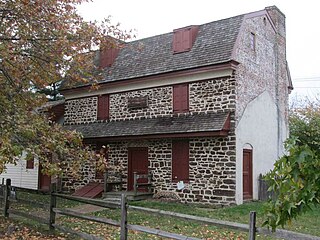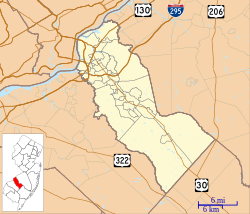
Camden is a city in Camden County, in the U.S. state of New Jersey. It is part of the Delaware Valley metropolitan region. The city was incorporated on February 13, 1828. Camden has been the county seat of Camden County since the county's formation on March 13, 1844. The city derives its name from Charles Pratt, 1st Earl Camden. Camden is made up of over 20 neighborhoods, and is part of the South Jersey region of the state.

The Steuben House is a noted example of Bergen Dutch sandstone architecture, located at New Bridge Landing on the Hackensack River in River Edge, in Bergen County, New Jersey, United States.

South Camden is a neighborhood in Camden, New Jersey. Located in the southern part of the city, below Central Waterfront and east of the Port of Camden on the Delaware River. Interstate 676 runs through the neighborhood.

The Gabreil Daveis Tavern House, also known as the Hillman Hospital House, is a historic building in the Glendora section of Gloucester Township, Camden County, New Jersey, United States. This tavern was built in 1756 near the Big Timber Creek and housed boatmen who used the creek to ship goods to Philadelphia. It was designated a hospital by George Washington during the Revolutionary War.

Glendale Methodist Episcopal Church is a historic church at 615 Haddonfield-Berlin Road, at the junction with White Horse Road, in the Glendale section of Voorhees Township, Camden County, New Jersey, United States. It was added to the National Register of Historic Places on August 4, 1995, for its significance in community planning, development, and education from 1855 to 1920. At the time of its construction, the village of Glendale was impacted by the train station stop of Ashland on the Camden Atlantic Railroad. Because of the railroad, Philadelphians and shore villagers came to trade and do business.

The Jonathan Pyne House, formerly the Richard Stites Jr. House, is located in Lower Township, Cape May County, New Jersey, United States. The house was built in 1694 and added to the National Register of Historic Places on February 14, 1997.

Pomona Hall is a colonial mansion located at 1900 Park Boulevard and Euclid Avenue, in Camden, Camden County, New Jersey, United States, that operates as a museum by the Camden County Historical Society. The first building on the site was constructed in 1718, while construction of the more substantial mansion house was started in 1726, with later additions made in 1788. It is not known when the house was first called Pomona Hall; but it is marked on Hill's Map of Philadelphia and Environs, published in 1809.

The Burrough–Dover House, also known as the Burrough–Dover Farmhouse, is located in Pennsauken Township of Camden County, New Jersey, United States. The historic stone house was added to the National Register of Historic Places on October 25, 1973, for its significance in exploration/settlement. Restoration work on the house has been performed by the Pennsauken Historical Society.

Griffith Morgan House is located in Pennsauken Township, Camden County, New Jersey, United States. The house was built in 1693 and added to the National Register of Historic Places on January 25, 1973.

The Port of Camden is situated on east bank of the Delaware River in Camden and Gloucester City in southern New Jersey. It is one of several ports in the Delaware Valley metro area port complex and is located near the mouth of Newtown Creek opposite the Port of Philadelphia. The port is one of the nation's largest for wood products, steel, cocoa and perishable fruit.

Cooper Library in Johnson Park is located in the Cooper Grant section of Camden, Camden County, New Jersey, United States. It was built in 1916 and was added to the National Register of Historic Places on March 11, 1980, for its significance in architecture, art, education, and sculpture. It is part of Rutgers University–Camden.

The United States lightship Barnegat (LV-79/WAL-506), is located in Camden, Camden County, New Jersey, United States. The lightship was built in 1904 and was added to the National Register of Historic Places on 29 November 1979.

Fairview, originally named Yorkship Village, is a neighborhood located in southern Camden, in Camden County, in the U.S. state of New Jersey. According to the 2000 United States census, Fairview Village has a population of 5,947. Much of the neighborhood is part of a historic district listed on the state and federal registers of historic places.

North Camden is a district of Camden, New Jersey. The population is 7,874. Cooper Point and Pyne Point are located in the area.

The Benjamin Cooper House is an 18th-century farmhouse and ferry house in Camden, New Jersey, in the United States. It is located at Erie Street in the Pyne Point neighborhood in North Camden. It was originally built in 1734 and served as a ferry stop as well as a residence. It later became a hotel and an entertainment venue. The building suffered extensive damage in a fire on Thanksgiving Day 2012.
History of Camden, New Jersey starts with the introduction of Quakers into the native lands of the Lenape population in the Delaware Valley. Throughout the city's history there have been times of economic growth and development; as well as stagnation and decline. The City of Camden was named after Camden County, which was named for Charles Pratt, 1st Earl Camden, who was a civil libertarian, promoter of the American cause, and a British judge and lawyer. The city was incorporated on February 13, 1828.

The Old Mine Road Historic District is a 687-acre (278 ha) historic district located along Old Mine Road in Sussex County and Warren County, New Jersey. It is part of the Delaware Water Gap National Recreation Area. The district was added to the National Register of Historic Places on December 3, 1980, for its significance in agriculture, archaeology, architecture, commerce, exploration/settlement, and transportation. It includes 24 contributing buildings and five contributing sites.

Glassboro is an inactive train station in Glassboro, New Jersey which served passengers from 1863–1971. Its station house was restored c. 2015. It is located at the edge of the Rowan University campus. Listed as the West Jersey Rail Road Glassboro Depot, it was added to the National Register of Historic Places on April 14, 2020, for its significance in architecture and transportation.
For the past 40 years, there have been many efforts made to the ease ailing economic health of Camden, New Jersey. The state of New Jersey has awarded more than $1.65 billion in tax credits to more than 20 businesses through the New Jersey Economic Opportunity Act. Corporate beneficiaries of the tax credits include Subaru, Lockheed Martin, American Water, Holtec. and others.






















